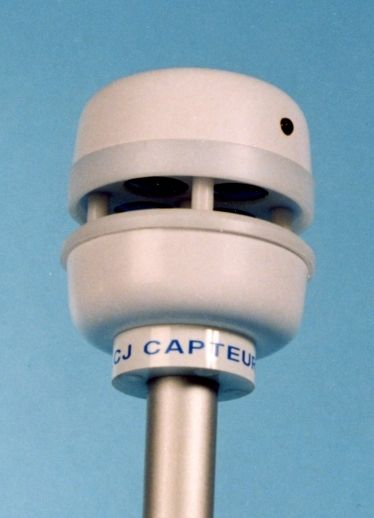CV3F Wind Sensor

Sensitivity : .5 Knots
Resolution : .1 Knot
Range : 0,5 to 99,5 knots
Wind direction sensitivity: + / - 1.5%
Wind direction resolution: .1%
12 or 24Vdc Models, please specify.
Power consumption : 50 mA
Beatrix has been without a wind sensor since we bought
her in 1997. The old unit was dead. This month we had the
opportunity to use a "man basket" on a large crane for working at the
masthead in fear and comfort, so we ordered a new CV3F wind sensor unit
imported from France by wiredboat.com and sold in the USA
by AR Engineering. This unit uses
ultrasonic pulses to determine wind speed and direction to the following
specifications:
|
CV3F Wind Sensor |

|
| Output: Apparent Wind Angle, Apparent Wind Speed, Air Temperature | |
| Specifications | |
| NMEA 183 digital output Sensitivity : .5 Knots Resolution : .1 Knot Range : 0,5 to 99,5 knots Wind direction sensitivity: + / - 1.5% Wind direction resolution: .1% 12 or 24Vdc Models, please specify. Power consumption : 50 mA |
It has no moving parts and requires no maintenance. A furthur advantage of this unit is compensation for boat heel. Cup sensors (anemometers) lose their accuracy when the boat is well heeled.

The output of the unit (NMEA 0183) feeds directly into our Cetrek Multi-2000 display units (one at the Nav Station and one on deck) and to the Cetrek Wind and Tack display units. Cetrek is no longer seriously marketed in the US anymore. They are largely marketed in Europe but are still available on special order. The CV3F works with any display unit that accepts NMEA 0183 data.
 |
CETREK Wind and Tack Displays. These are analog displays that complement the Cetrek MULTI-2000 displays. They are easier to read from a distance. On a cruising boat the Tack display is not so necessary, being an expanded scale from 50° to 50° designed for use when close-hauled. We were able to buy one at a close-out special. The 360 degree Wind Display will probably be purchased later. |
Work at the masthead took about 6 hours over 2 days. The "man basket" is a great way to do it if you have a friend with a huge crane. I had all my tools, 120V power, and the use of two hands. The basket is an aluminum box about 4 feet square and although it was perfectly safe I still felt uncomfortable, especially the first day which was cold and windy. Going up the mast in any contraption will remain a discomforting thing for me.
The CV3F communicates over a very small single conductor coax cable (about 1/4" dia.), which is amazing to me! No multi-conductor fat cables. This cable carries power to the unit and signals to the "black box" that converts the signals to NMEA 0183 sentences. Patti and Sarah were able to pull the cable through the mast using the nylon "mouse" line I had left in it 4 years ago with only a bit of careful tugging. Other "black boxes" are available for a variety of outputs (e.g. RS232 and analog signals) but most boaters will use NMEA.
Note that I also intended to install a Forespar static dissipater as part of a lightning protection system but changed my mind after doing some research on the subject. (see my web page on Lightning Protection on Sailboats. They simply do not do anything! Instead I have installed a lightning rod system which should protect the boat. Nothing will actually protect the electronics if you get a direct hit.
I also made the Windex support stronger (I broke the last one while up the mast), but it also is much more ideal as a bird perch than the previous one!
Last modified: March 23 2014 03:38